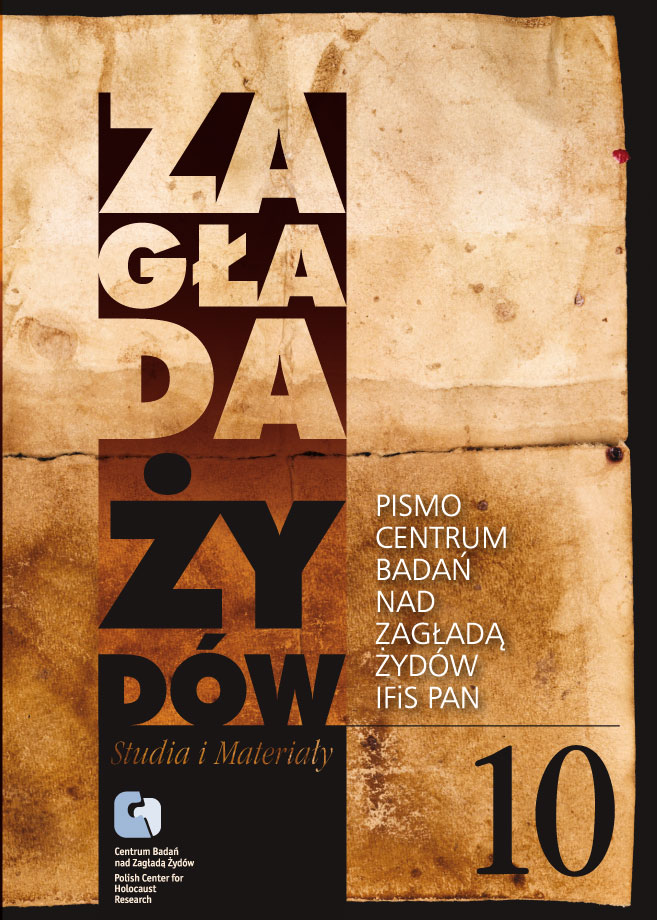Józef Kermisz (1907–2005) – twórca badań nad Szoa
Zagłada Żydów. Studia i Materiały, Nr 10 (2014), Strony: 304-316
Data zgłoszenia: 2020-10-22Data publikacji: 2014-12-01
 https://doi.org/10.32927/ZZSiM.526
https://doi.org/10.32927/ZZSiM.526
Abstrakt
Józef Kermisz (1907–2005) was a historian and an archivist who helped lay the foundations for Shoah research in Poland and Israel. In 1944 joined the Central Jewish Historical Commission where became the chief archivist. Since then his life has been devoted to retrieving wartime archival material. As archive director (in the Jewish Historical Institute in Poland and at Yad Vashem in Israel) he sought to develop an archive both for future historical research and for trials of suspected war criminal. He played a major role in discovering and preserving important documentation on the Shoah in Poland. Among his major professional achievements were preparing documentation for the prosecution in the Eichmann trial, and publishing Czerniakow’s diary and the full edition of the underground press of the Warsaw ghetto. He was one of the world’s leading experts on the Ringelblum Archive and other hidden Jewish documentation from the Holocaust. Kermisz left behind a legacy of a vast research infrastructure that he created and that will occupy scholars for generations.
Licencja
Prawa autorskie (c) 2014 Autor&"Zagłada Żydów. Studia i Materiały"

Utwór dostępny jest na licencji Creative Commons Uznanie autorstwa 4.0 Międzynarodowe.
https://creativecommons.org/licenses/by/4.0
Czasopismo publikowane jest w standardzie Diamond Open Access na licencji CC-BY-4.0 Deed - Uznanie autorstwa 4.0 Międzynarodowa - Creative Commons
Inne teksty tego samego autora
- Avner Shalev, Dan Michman, David Silberklang, Ścisła pamięć o Zagładzie w Muzeum Historii Holokaustu w Yad Vashem. Odpowiedź na artykuł Amosa Goldberga , Zagłada Żydów. Studia i Materiały: Nr 7 (2011)
Podobne artykuły
- Aleksandra Bańkowska, Agnieszka Haska, „…w podziemiach wymienionych domów zakopane są…”. Poszukiwania Archiwum Ringelbluma , Zagłada Żydów. Studia i Materiały: Nr 12 (2016)
- Katrin Stoll, Rozkład jazdy tylko w jedną stronę. Przesłuchania byłych urzędników Reichsbahn na temat deportacji Żydów z Prużan do Auschwitz w 1943 r. , Zagłada Żydów. Studia i Materiały: Nr 12 (2016)
- Andrzej Leder, Konsekwencje doświadczenia Zagłady dla polskiej świadomości (i nieświadomości) społecznej , Zagłada Żydów. Studia i Materiały: Nr 14 (2018)
- Joanna Tokarska-Bakir, Logika uniku. O protokole audiencji Josepha Tenenbauma u prymasa Augusta Hlonda 3 czerwca 1946 r , Zagłada Żydów. Studia i Materiały: Nr 14 (2018)
- Dariusz Libionka, Alina Skibińska, “I swear to fight for a free and mighty Poland, carry out the orders of my superiors, so help me God.”Jews in the Home Army. An Episode from Ostrowiec Świętokrzyski , Zagłada Żydów. Studia i Materiały: 2008: Holocaust Studies and Materials
- Maria Ferenc, Empatia jako szansa i jako ograniczenie , Zagłada Żydów. Studia i Materiały: Nr 15 (2019)
- Adam Kopciowski, Dariusz Libionka, Relacja działaczki Poalej Syjon-Lewicy Poli Elster o sytuacji na Umschlagplatzu i w transporcie do Poniatowej w kwietniu 1943 r , Zagłada Żydów. Studia i Materiały: Nr 19 (2023)
- Małgorzata Preuss, ARCHITEKCI ZAGŁADY – analiza funkcjonowania Centralnego Zarządu Budowlanego w KL Auschwitz-Birkenau , Zagłada Żydów. Studia i Materiały: Nr 2 (2006)
- Roma Sendyka, Niewinni winni. Strategie bezpieczeństwa mnemonicznego w kraju po Zagładzie , Zagłada Żydów. Studia i Materiały: Nr 15 (2019)
- Katarzyna Woniak, Ujęcie Zagłady w niemieckich podręcznikach szkolnych , Zagłada Żydów. Studia i Materiały: Nr 11 (2015)
<< < 1 2 3 4 5 6 7 8 9 10 11 12 13 14 15 16 17 18 19 20 21 22 23 24 25 26 27 28 29 30 31 32 33 34 35 36 37 38 39 40 41 42 43 44 45 46 47 48 49 50 > >>
Możesz również Rozpocznij zaawansowane wyszukiwanie podobieństw dla tego artykułu.
 English
English
 Język Polski
Język Polski




